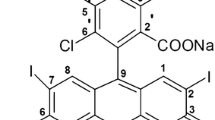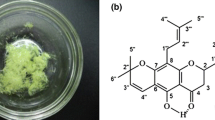Abstract
Magnolia bark is an edible traditional Chinese medicine that has antibacterial activity against Staphylococcus aureus. In the present study, interactions between S. aureus DNA and raw magnolia bark (RMB) and ginger mix-fried magnolia bark (GMB) aqueous extracts were determined via spectroscopic methods. Fluorescence spectroscopy and Stern–Volmer constants showed that S. aureus DNA quenched the fluorescence of the extracts by static quenching. UV–Vis spectroscopy and iodide quenching experiments indicated that the interactions between S. aureus DNA and the fluorescent substances might involve groove binding or electrostatic interactions. In 4′, 6-diamidino-2-phenylindole competitive assays, the fluorescence intensity at decreased as the extract amount was increased. This indicates that groove binding is responsible for the fluorescence quenching. The antibacterial activity of GMB aqueous extract treated under light, cold, heat and cycling hot–cold conditions decreased by 13.99, 9.31, 10.89 and 14.40%, respectively, whereas that of RMB aqueous extract treated under the same conditions decreased by 8.91, 14.99, 14.99 and 13.70%, respectively. The results indicate that S. aureus DNA quenches the fluorescence of GMB and RMB aqueous extracts by grooving interactions. Additionally, the antibacterial activities of GMB and RMB extracts are sensitive to light and temperature, respectively.




Similar content being viewed by others
References
Amorati R, Zotova J, Baschieri A (2015) Antioxidant activity of magnolol and honokiol: kinetic and mechanistic investigations of their reaction with peroxyl radicals. J Org Chem 80:10651–10659
Anantharaman A, Priya RR, Hemachandran H (2015) Studies on interaction of norbixin with DNA: multispectroscopic and in silico analysis. Spectrochim Acta A Mol Biomol Spectrosc 144:163–169
Bang KH, Kim YK, Min BS (2000) Antifungal activity of magnolol and honokiol. Arch Pharm Res 23:46–49
Benevides BJ, Marques FM, Figueira MM (2017) Potential anti-inflammatory, antioxidant and antimicrobial activities of Sambucus australis. Pharm Biol 55:991
Bera R, Sahoo BK, Ghosh KS (2008) Studies on the interaction of isoxazolcurcumin with calf thymus DNA. Int J Biol Macromol 42:14–21
Bi S, Qiao C, Song D (2006) Study of interactions of flavonoids with DNA using acridine orange as a fluorescence probe. Sens Actuators B Chem 119:199–208
Chilampalli C, Zhang X, Kaushik RS (2013) Chemopreventive effects of combination of honokiol and magnolol with α-santalol on skin cancer developments. Drug Discoveries Therapeutics 7:109–115
Dodds MW, Tian M, Inui T (2019) Synergistic antibacterial effects of magnolia bark extract and l-arginine, n-alpha-lauroyl ethyl ester on plaque biofilm. US Patent 10,265,367, 23 Apr 2019
Fried LE, Arbiser JL (2009) Honokiol, a multifunctional antiangiogenic and antitumor agent. Antioxid Redox Sign 11:1139–1148
Hu P, Chen X, Whitener RJ (2013) Effects of parabens on adipocyte differentiation. Toxicol Sci off J Soc Toxicol 131:56
Hu L, Yin C (2015) Multi-way calibration coupling with fluorescence spectroscopy to determine magnolol and honokiol in herb and plasma samples. Anal Methods-UK 7:5913–5923
Jans C, Merz A, Johler S (2017) East and West African milk products are reservoirs for human and livestock-associated Staphylococcus aureus. Food Microbiol 65:64
Kim SY, Kim J, Jeong SI (2015) Antimicrobial effects and resistant regulation of magnolol and honokiol on methicillin-resistant Staphylococcus aureus. Biomed Res Int 2015:283630
Lakowicz JR (2006) Quenching of Fluorescence. Principles of Fluorescence Spectroscopy. Springer, Boston, pp 257–301
Li YQ, Han Q, Feng JL (2014) Antibacterial characteristics and mechanisms of ɛ-poly-lysine against Escherichia coli and Staphylococcus aureus. Food Control 43:22–27
Li YC, Gao JJ, Zhang WM (2001) Change of total content of magnolol and honokiol in cortex magnoliae officinalis before and after ginger mix frying. Chinese Tradit Pat Med 23(6):415–417. https://doi.org/10.3969/j.issn.1001-1528.2001.06.010
Li T, Yang SR, Chen M (2016a) Antibacterial mechanism of ginger mix-fried magnolia bark extract against Escherichia coli and Staphylococcus aureus. Mod Food Sci Technol 32:84–92
Li WL, Zhao XC, Zhao ZW (2016b) In vitro antimicrobial activity of honokiol against Staphylococcus aureus in biofilm mode. J Asian Nat Prod Res 18:1178–1185
Lin YR, Chen HH, Ko CH (2007) Effects of honokiol and magnolol on acute and inflammatory pain models in mice. Life Sci 81:1071–1078
Liu BM, Bai CL, Zhang J (2015) In vitro study on the interaction of 4,4-dimethylcurcumin with calf thymus DNA. J Lumin 166:48–53
Maisch T (2015) Resistance in antimicrobial photodynamic inactivation of bacteria. Photochem Photobiol Sci off J Eur Photochem Assoc Eur Soc Photobiol 14:1518
Münch AS, Katzsch F, Weber E (2013) Synthesis, spectroscopic characterization and structural investigation of a new symmetrically trisubstituted benzene derivative: 3,3 ’,3 ’ ’–(Benzene–1,3,5–triy1) tripropiolic acid. J Mol Struct 1043:103–108
Pan J, Wang L, Zhang G (2015) Intercalation of 2-butyl-4-methylphenol to G-C rich region of DNA and the role of hydroxypropyl-β-cyclodextrin. J Photochem Photobiol B 151:125–134
Pyle AM, Rehmann JP, Meshoyrer R (1989) Mixed-ligand complexes of ruthenium (II): factors governing binding to DNA. J Am Chem Soc 111:3051
Sahoo BK, Ghosh KS, Bera R (2008) Studies on the interaction of diacetylcurcumin with calf thymus-DNA. Chem Phys 351:163–169
Sakaue Y, Domon H, Oda M (2016) Anti-biofilm and bactericidal effects of Magnolia bark-derived magnolol and honokiol on Streptococcus mutans. Microbiol Immunol 60:10–16
Sarwar T, Rehman SU, Husain MA (2015) Interaction of coumarin with calf thymus DNA: deciphering the mode of binding by in vitro studies. Int J Biol Macromol 73:9–16
Sauer M, Hofkens J, Enderlein J (2011) Handbook of fluorescence spectroscopy and imaging: from single molecules to ensembles. Wiley-VCH, Weinheim
Shah A, Nosheen E, Munir S (2013) Characterization and DNA binding studies of unexplored imidazolidines by electronic absorption spectroscopy and cyclic voltammetry. J Photochem Photobiol B 120:90–97
Sun L, Liao K, Wang D (2015) Effects of magnolol and honokiol on adhesion, yeast-hyphal transition, and formation of biofilm by Candida albicans. PLoS ONE 10:e117695
Wang YQ, Zhang HM, Cao J (2014) Binding of a new bisphenol analogue, bisphenol S to bovine serum albumin and calf thymus DNA. J Photochem Photobiol B 138:182–190
Watson JD, Crick F (2003) Reprint: molecular structure of nucleic acids [dhelix]. Ann Intern Med 138:581–582
Yang X, Zhang M, Wang RK (2017) Effects of magnolol and honokiol on the morphology and cellular membrane permeability of Streptococcus mutans. Chin J Conserv Dent. https://doi.org/10.1111/1348-0421.12343
Zhang YZ, Xia X, Ping M (2009) Spectroscopic studies on the interaction of Congo red with bovine serum albumin. Spectrochim Acta Part A Mol Biomol Spectrosc 72:907–914
Zuo GY, Zhang XJ, Han J (2015) In vitro synergism of magnolol and honokiol in combination with antibacterial agents against clinical isolates of methicillin-resistant Staphylococcus aureus (MRSA). BMC Complement Altern Med 15:425
Acknowledgements
This study was supported by a grant from the National Natural Science Foundation of China (No. 31401390). The authors also thank the Promotional Project for Postgraduate Research Capabilities (2017) for their financial support.
Author information
Authors and Affiliations
Corresponding author
Ethics declarations
Conflict of interest
The authors declare that they have no conflicts of interests.
Additional information
Communicated by Erko Stackebrandt.
Publisher's Note
Springer Nature remains neutral with regard to jurisdictional claims in published maps and institutional affiliations.
Rights and permissions
About this article
Cite this article
Cui, SM., Liang, Hy., Li, T. et al. Interaction of magnolia bark extracts with Staphylococcus aureus DNA and evaluation of the stability of their antibacterial activities. Arch Microbiol 203, 5215–5224 (2021). https://doi.org/10.1007/s00203-021-02501-5
Received:
Revised:
Accepted:
Published:
Issue Date:
DOI: https://doi.org/10.1007/s00203-021-02501-5




